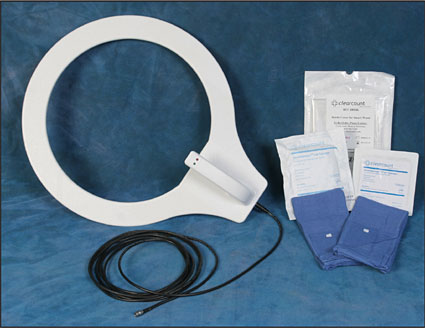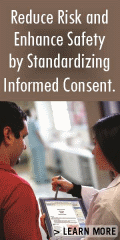 |
 |
 |

September / October 2008

Objects Retained During Surgery: Human Diligence Meets Systems Solutions
By Petra S. Berger, PhD, RN, CPHRM;
and Gordon Sanders, RN, BSN, CPHRM
Soon healthcare facilities will need to absorb the direct cost of objects retained during surgery because these occurrences are now considered "preventable conditions" for which the Centers for Medicaid & Medicare Services won't pay (U.S. Department of Health & Human Services, 2007). The costs to remove a retained foreign body can run up to $50,000 per case (Jaspen, 2008), making it a costly human oversight and, more importantly, a most risky circumstance for patients.
What are recommended preventive actions? Equally important, how can we achieve long-term sustainability in improved practices? It was suggested in a closed-claims study that in 88% of the cases involving retained instruments in which a count was conducted, the count was documented as being correct (Gawande et al., 2003). Thus, a gap exists between well-designed patient safety action steps and sufficient provider adherence to these action steps on a consistent basis.
As a case in point, in 2001, a surgeon left a 13-inch retractor inside a patient during cancer surgery at a Wisconsin hospital. This hospital had an established policy to perform instrument counts. "It's like a pilot having a check-off manual in the cockpit, but nothing is checked off," according to Eric Farnsworth, a Madison, Wisconsin, malpractice attorney. "These things don't work if they're not used." And Mark Kirschbaum, vice president for quality at University of Wisconsin Hospital, believes that they must stay vigilant and have an unwavering commitment to monitoring how we safely deliver health care services (Wahlberg, 2007).
Prevalence
The most common items left behind include sponges and towels, instruments and sharps, and device fragments, including pieces of wire or tubes (Jaspen, 2008; Gawande, et al. 2003; U. S. Food and Drug Administration, 2008).
Adequate information is not available regarding the rates of unintentionally retained surgical objects. Most of the information comes from insurance company claims data. Estimates of actual numbers of surgeries with objects left behind range from 1 in every 1,000 procedures to 1 in every 19,000 surgeries, with the Veterans Health Administration (VHA) citing their own rate of about one in 6,000 (Gawande et al., 2003; Dept. of Veterans Affairs, 2006). Even though exact numbers are unknown, it can be assumed that this adverse medical event outnumbers all others in the surgical setting, including wrong-site surgeries and surgical fires (ECRI Institute, 2003).
Liability Analysis
In general, the legal doctrine res ipsa loquitur (i.e., the thing speaks for itself) holds that a retained foreign object is de facto due to someone's negligence. One exception involves surgical emergencies, in which reliable counts may not always be done because of a compelling need to close the patient; any retained instruments are removed later (ECRI Institute, 2003).
According to the Association of periOperative Registered Nurses (AORN; 2007), "The 'captain of the ship' doctrine is no longer assumed to be true, and members of the entire surgical team can be held liable in litigation for retained foreign bodies."
Adverse Effects on Patients
Based on an ECRI Institute study (2003) that examined Controlled Risk Insurance Company closed-claims data from 1985 to 2001, patient deaths due to retained surgical objects were rare. More common adverse outcomes included:
- readmission to hospital or prolonged length of stay (59% of cases),

- second surgery to remove retained object (69%),

- sepsis or infection (nearly 50%),

- fistula or small-bowel obstruction (15%), and

- visceral perforation (7%).
Only 6% of retained instruments were discovered within one day of surgery, while discovery around the 21st day after surgery was more common. However, some retained objects were not discovered until many months or even years later (Gawande et al., 2003).
Risk Factors
Understanding some of the risk factors can more rapidly point to effective interventions. In a study published by The New England Journal of Medicine (Gawande et al., 2003), the risk of foreign body retention after surgery:
- increased nine-fold during emergency surgeries,

- increased four-fold with unplanned changes in surgical procedure,

- increased with patients with higher body mass index,

- doubled when involving more than one surgical team in a surgical procedure, and

- increased with greater blood loss during the procedure.
The location of retained objects was found to be the abdomen or pelvis (in 54% of cases), the vagina (22%), and the thorax (7%).
Strategies for Sustainable Solutions
The segment between strategies and results (i.e., the process of sustained practice change by nurses, physicians, and allied staff) continues to present a challenge. Setting the expectation of a planned approach to counting sponges, towels, sharps, and instruments, beginning at the front end of every surgical procedure, can compel an encompassing mindset of paying close attention to detail and, therewith, incrementally creating a "culture of safety."
Although systems issues, such as interruptions and distractions, are involved in incorrect counts, we must support diligent practices by all surgical team members so they adhere to established procedures and avoid human oversight. This challenge is steep with manual surgical counts, which may eventually be replaced by technological solutions.
Meantime, it is proposed that improved outcomes are achievable through:
- evidence-based recommendations by professional agencies,

- built-in cognitive reminders and technology support,

- education and simulated learning experiences, such as drills of counting protocols (AORN, 2008), and

- most importantly, monitoring actions taken by surgeons and staff members; pertinent quality measures can be obtained through formal risk assessments such as:
- periodic direct practice observation and medical record review, and

- provider interviews about practice flow and existing barriers.
Recommendations by ACS,
FDA, and AORN
The American College of Surgeons (2005) provides guidelines that recommend:
- standardized counting procedures for sponges, sharps, instruments,

- methodical wound exploration before closure,

- use of X-ray detectable items within the surgical wound,

- effective communication among perioperative team members, and

- thorough documentation of surgical counts:
- documentation of actions taken when discrepancies occur,

- documentation when counts are waived.
Regarding device fragments, the U.S. Food and Drug Administration (2008) recommends:
- Inspect devices prior to use for damage during shipment or storage that might increase the likelihood of fragmentation during a procedure.

- Inspect devices immediately upon removal from the patient for any signs of breakage or fragmentation.
Recommendations by AORN (2007) related to counts include:
- Use radiopaque (X-ray detectable) sponges and towels within surgical wounds:
- Postsurgical dressings and external towels should not be radiopaque because they can obstruct views on X-ray.
- Radiopaque sponges should not be cut because of embedded indicators.

- Audible counting by two healthcare workers including at least one RN.

- Timing of counts — baseline, after any updates such as when instruments are added, at change of staff, at start of wound closure, and at end of procedure for all layers of tissue closure.

- Location of count: from surgical site to Mayo stand to discarded items, in same standardized sequence.

- Specify responsible team member(s).

- Count prepackaged sponges and instrument sets:
- Counts printed on outside of package should be verified before use.

- Preprinted count sheets to match standardized instrument sets are useful.
- Effective reconciling of any count discrepancy:
- Notify surgeon, perhaps delay wound closure.

- Thoroughly search OR environment and wound.

- Consider portable X-ray scanner.
- Consider reading of X-ray by radiologist instead of by surgeon.

- Safe disposal of sponges and sharps, according to OSHA guidelines.

- Document counts:
- Timing and number of counts, results obtained, and surgeon notified.

- Personnel involved in count.

- Instruments or sponges (wound packing) intentionally remaining within the patient.

- All reasonable efforts made and actions taken to respond to discrepancy.

- Rationale if count is skipped, e.g., emergency case.
Cognitive Reminders and
Technology Support
A new technology in which sponges are embedded with radio frequency identification chips supports, and may someday replace, manual counting of surgical sponges. With this technology, a wand is waved over the patient by the surgical nurse to detect if any sponges remain (Wahlberg, 2007; Ohio State, 2008). See Figure 1.


|
 |
 |
 |


















|
 |

